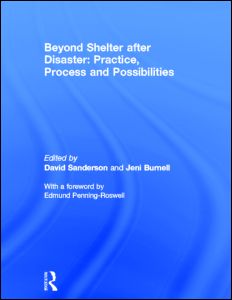Beyond Shelter after Disaster: Practice, Process and Possibilities
Edited by David Sanderson, Jeni Burnell
Published 18th March 2013 by Routledge – 166 pages
Description:
Providing shelter after a disaster is recognised as one of the most complex areas of humanitarian relief and recovery. Some aid agencies have stopped providing shelter altogether after bad experiences, while those that do quickly become engaged in challenges that go far beyond the provision of structures alone. Yet with the number and severity of disasters set to increase, due to climate change and rapid urban growth, the need for approaches that work has never been greater.
This book explores the issues in three parts. The first, Practice, looks at lessons from past efforts. Part two, Process, proposes practical and effective people-centred approaches. Part three considers currently neglected issues such as disability, human rights and urban-oriented approaches. Through practical case studies and academic research, Beyond Shelter after Disaster critiques past methods and explores future options for improving practice in one of the most complex areas of post disaster relief and recovery.
This book was originally published as a special issue in Environmental Hazards: Human and Policy Dimensions.
Contents:
1. Introduction. Beyond shelter after disaster: practice, process and possibilities
Part one: practice 2. What have we learned from 40 years’ experience of Disaster Shelter?
3. Harnessing time: Reflections on constraints to development
4. Post-disaster reconstruction: A current analysis of Gujarat’s response after the 2001 earthquake
3. Harnessing time: Reflections on constraints to development
4. Post-disaster reconstruction: A current analysis of Gujarat’s response after the 2001 earthquake
Part two: process
5. Resilient dwellings or resilient people? Towards people-centred reconstruction
6. Community-led resettlement: from a flood- affected slum to a new society in Pune, India
7. Lost in translation? The challenges of an equitable post-disaster reconstruction process: lessons from Chile
5. Resilient dwellings or resilient people? Towards people-centred reconstruction
6. Community-led resettlement: from a flood- affected slum to a new society in Pune, India
7. Lost in translation? The challenges of an equitable post-disaster reconstruction process: lessons from Chile
Part three: possibilities 8. Is there a human right to shelter after disaster?
9. Can humanitarian responses in urban areas reinforce underlying causes of vulnerability? Tweaking a livelihoods analysis of inequality and infrastructure in splintering cities
10. From research to practice (and vice versa) for post-disaster settlement and shelter
11. Disability and public shelter in emergencies
9. Can humanitarian responses in urban areas reinforce underlying causes of vulnerability? Tweaking a livelihoods analysis of inequality and infrastructure in splintering cities
10. From research to practice (and vice versa) for post-disaster settlement and shelter
11. Disability and public shelter in emergencies
For more information: http://www.routledge.com/books/details/9780415814232/









0 Comment :
Post a Comment
Thanks for your comment!